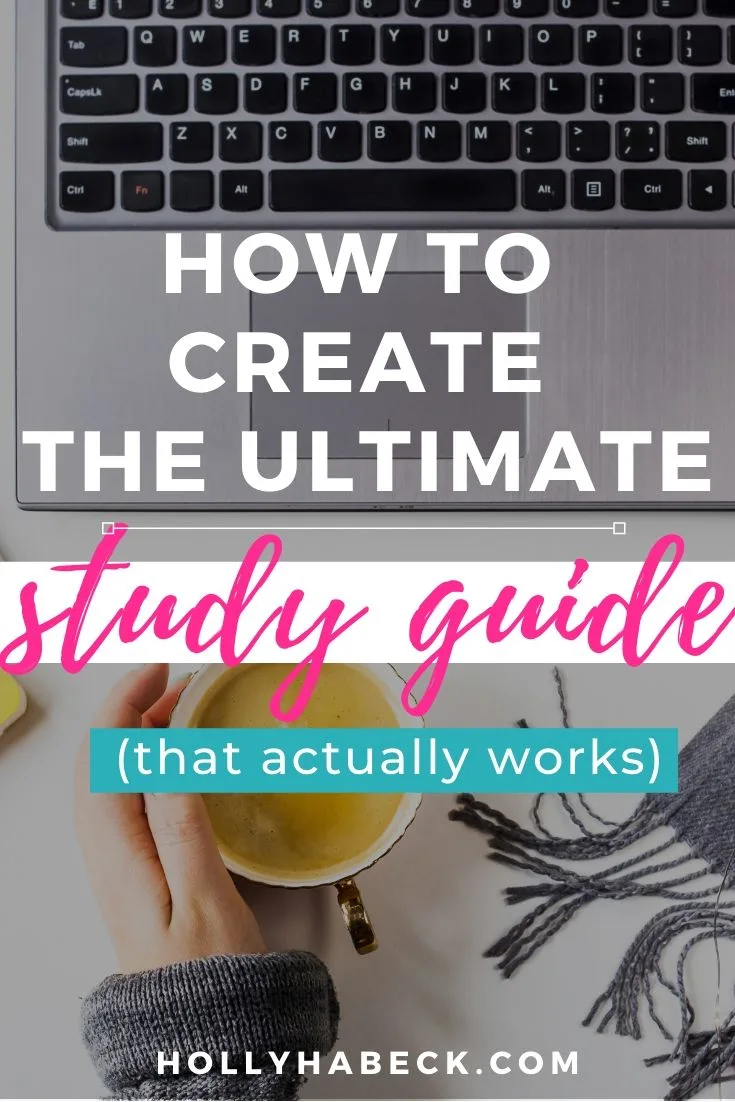Check out these tips on how to make a study guide that actually works, plus a few items on avoiding distraction while studying, and you’ll be on your way to an A in no time.
As an Amazon Associate I earn from qualifying purchases. Therefore, this post may contain affiliate links, meaning I make a small commission on qualifying purchases made through these links, at no additional cost to you.

How to Make a Study Guide
Making a study guide can be tedious work, but the payoff is tenfold if you value a high grade.
The first step in how to make a study guide though is to take a moment, step back, and think about how you learn best.
This will determine your study guide format.
But first, what is a study guide?
For those of you who don’t know, a study guide is a compilation of all the information necessary for acing a test.
It’s an in-depth study aid that will help you review course material and quiz yourself on your knowledge of a particular subject.
Thanks majorly to proficient study guides, I was able to maintain over a 3.8 GPA throughout my time in college and graduate with honors.
So yeah, they really do work!

Study Guide Format & Study Guide Template Ideas
Believe it or not, there are infinite methods for an effective study guide format. Check out a few of the below options, and choose which study guide template works best for you and the course material.
Also: If you’re wondering how to make a study guide, besides choosing one of the study guide templates below, my suggestion is to create a study guide using Microsoft Word.
It’s the easiest way to input a large amount of information, organize it, and print it for reference.
Bullet Point Study Guide
Bullet point study guides are an ideal option for students that overthink.
Basically, each important term or concept has its own line, with a small bulleted list directly below it of descriptor words and information on that topic and/or concept.
If you find yourself getting immersed in the fine details or easily confused on particular concepts, this is a good way to break things down and take a look at the bigger picture while you’re studying.

Visual Study Guide
If you’re a visual learner, then a visual study guide might just be for you.
Utilize tools like graphs, diagrams, and pictures to breakdown important concepts to prepare for your exam.
You can format this study guide just like the bullet point study guide, but instead of bullet points for each concept, include explanatory graphs/diagrams/images under each topic.
If you’re taking a relatively common course, there should be plenty of options for images online that you can pull from and input into a Microsoft Word document.
You can also check your textbook for visual resources and photocopy any helpful items to attach to your study guide for reference.
Related: How to Graduate College Early — The Ultimate Guide

Dictionary Style Study Guide
One of my personal favorite ways to study always included creating a dictionary style study guide.
As a marketing student, many of my courses required us to remember specific marketing concepts and strategies.
My study guides would often list out each of the concepts with a classic, dictionary style description pulled straight from the textbook (i.e. formatted in a Microsoft Word document with each term having its own line followed by the dictionary/textbook definition).
I’d then remember the description and easily nail the test, as many professors pull quotes and examples directly from the textbook for exam material.
Just make sure you actually understand the definitions of each concept before you memorize the information.
A dictionary definition won’t do you any good if you’re not able to put an idea into your own words.
In-Depth Study Guide
An in-depth study guide is a combination of every study guide format listed above.
It’s best suited for complex subject matter, where you’ll need a variety of definitions, diagrams/images, and bullet point information to fully grasp a concept.
This would involve breaking down course material using dictionary definitions of concepts, diagrams/images/graphs, and also including bullet points from lectures or textbook materials.
So, each topic you need to review for the test would have its own section, followed by bullet points, diagrams/images/graphs, as well as a dictionary definition of the term.
You would then review this information thoroughly until you’ve memorized all key concepts.

Additional Study Aids
Sometimes just knowing how to make a study guide isn’t enough. I skated by in college majorly with the help of study guides, but there are additional study aids to help your brain latch onto material and use it to ace an exam.
Some of these study aids include flashcards, power points, prewritten study guides for purchase, explanatory videos, and additional reading on a subject.
Not to mention, you should always consult your professor on a one-on-one basis during office hours if there is a certain concept you do not understand or need more help with before a test.
Tips for Succcess
Knowing how to make a study guide is essential for exam success.
That being said, there are a few other tips to help avoid distraction and actually put those study guides to good use…
Don’t Be Disturbed
One surefire way to eliminate distraction is by putting your phone/computer into “do not disturb” mode.
Nobody wants to do it and it takes a lot of self-discipline, but it’s totally worth it to have an in the zone, side-convo-free study session.
Those texts will still be there waiting for you after you’re done working.
Choose Your Location Wisely
Even though laptops/tablets/etc. make it easy to work from home, not every potential study spot is created equally.
Choose an environment where you know there will be few distractions.
Example: I know I need to isolate myself from my friends if I actually want to get things done. Therefore, I migrated to my bedroom in my college apartment when it was time to do work.
The same principles apply for people who thrive off of group study environments.
Seek out the situation in which you perform best and use it to your advantage!
Related: The Most Important Lessons I Learned in College

Set the Mood
If you prefer to study from home, like I did, it can be extremely beneficial to “set the mood” before you begin working.
I sounds silly, but the whole point is to setup your space in a way that works for you (i.e. promotes focus, reduces stress).
For me, this included tidying up my space, getting out some essential oils, and putting on the ultimate finals playlist.
These are all things that helped me to get relaxed and in the zone for a long day/night of studying.
Make a List
There’s something about to-do lists that just works.
It’s satisfying crossing each item off of the list, so it can motivate you to do things you may otherwise brush off.
It also prevents you from forgetting all of the things you have yet to do.
Sure, there’s a part of you that may want to forget about some of those things, but you (and your GPA!) will rejoice when you’ve nailed that A as a result of your hard work and dutiful task management.
Reward Yourself
One of the biggest challenges when it comes to studying is thinking of all of the other things you’d rather be doing, right?
Whatever it is that you enjoy (for me, it’s currently How to Get Away With Murder on Netflix), try postponing it until you’ve accomplished an item on your to-do list (or have completed the entire list, if you want to get ambitious).
This should help you stay motivated throughout your study sessions, knowing that there will be a reward/relaxation at the end.
However, just be wary that you don’t rush through your work to get to the reward!



